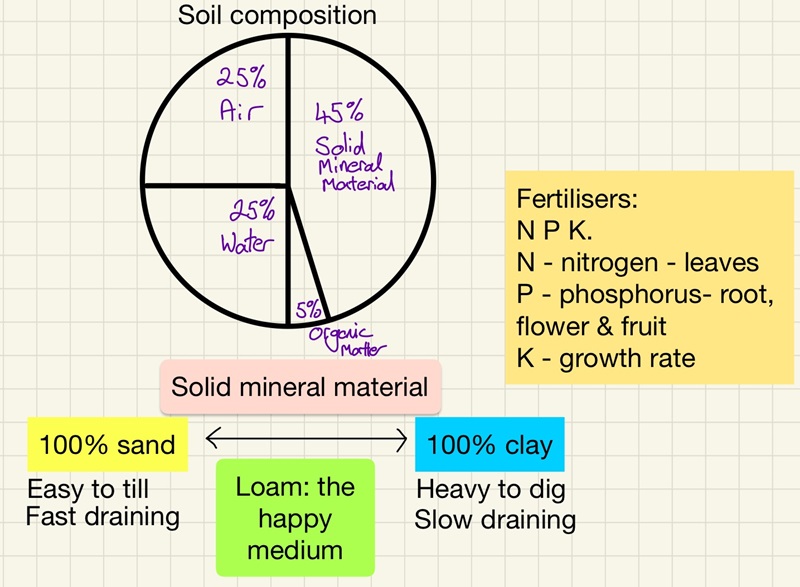Land-Based: Use of Science
What we are learning: (component knowledge)
Use of Science in land based industries

In this topic, which is the largest of the three sections, we look at the science of the land and how we can use science to maximise the efficiency and care for the land, the crops and the livestock.
This topic is approximately 50% of the theory content
Cells and the structure & function of plants:

Plants, like animals, have a variety of specialised cells. In the leaf (a plant organ) we have a waxy cuticle to reduce evaporation then transparent upper epidermis cells (to let as much light through as possible). Next we have the palisade cells that are crammed with chloroplasts (full of chlorophyll) to maximise photosynthesis. Below this is the spongy mesophyll which has lots of gaps to allow gases in an out. Below this are the guard cells which open and close as required.
For photosynthesis to occur, we need light, carbon dioxide, water and chlorophyll in chloroplasts.
Transpiration is the process that brings water into plants. As water evaporated from the leaves of a plant, the water is then drawn out of the stem to replace the water lost from the leaves. This, in turn, draws water through the roots into the stem. Transpiration is faster when:
• There is more light (increase in photosynthesis),
• It is warmer (higher temperature),
• There is more wind (increased air flow),
• The humidity falls (water evaporates more easily if the air is dryer).
Plant growth:

This section needs us to understand about plant reproduction. Even if, through farming, you simply buy seeds and you do not collect them yourselves from plants, it is important to know how they are produced. Here is a basic reminder of the role of flowering plants.
Soil:

Soil composition, soil testing, pH, minerals and issues with lack of minerals.
We need to know the composition of soil, here is some information about testing the texture of the soils. There is the further information about how this links to what can be most efficiently grown in that soil type from the Royal Horticultural Society.
There is also information about soils from around the UK provided by LandIS.
Generally soil should be (approximately) 45% solid mineral matter, 25% air, 25% water and 5% organic matter.
Fertilisers are added to increase fertility of the soil. This adds to or replaces some of the organic matter. It provides essential minerals. In chemical fertilisers, we see NPK values. See in more detail the effect of lacking in these minerals.
This video shows a simple method of testing soils to see the proportions of sand, silt/loam and clay.
Caring for plants:

Care to maximise production.
One way to maximise plant growth and production is by using hydroponics. This method allows more surface area of growing, tighter control of growth without reliance on seasons and natural soils. This video also shows an application using hydroponics to feed livestock.
Fertilisers:
This really deserves its own section. Fertilisers can either be natural (manure or compost) or they can be chemical. Chemical fertilisers can be rich in different elements, particularly NPK and they are needed for different types of plants and stages:
• N - Nitrogen - plant growth,
• P - Phosphorus - root development,
• K - Potassium - flowers and fruit.
Fertilisers are also added at different times to target specific times in the life of a plant. Some are added early to promote germination, then more to target rapid growth, and (if applicable), ones to support flowering and fruit development. Fertilisers can have a negative effect on the environment, particularly in water sources where eutrophication can occur. It is essential to avoid adding an excess of fertiliser (also because it is expensive) and to avoid adding it if the ground it too wet as the nutrients can be washed away. Finally, as these fertilisers are soluble, if the ground is too dry, they will be blown away and not absorbed by the plants.
Plant pests and diseases:

Animal digestion:

The main difference to be aware of regards the type of digestive system that an animal has. Pigs, like us, have a monogastric system. This means that they have a single “stomach”. Animals that process more food that is made up of the harder to digest material called cellulose, will have more “stomachs”. These animals are called ruminants. By having more chambers, they can extract more energy from the cellulose that animals like us and pigs would not get as much from. Examples of ruminants are: cows, goats, sheep, deer and chickens. The processes that happen in the different parts of the digestive system can be found in the GCSE biology section.
Diet, needs and effects of deficiency:

A balanced diet is important for both maximising the yield, but also for the welfare of the animals.
An unbalanced diet for dairy cows can result in:
• Lower milk production,
• Loss of weight,
• Gaining too much weight,
• Deficiency diseases caused by the lack of specific nutrients or vitamins,
• Cattle may become susceptible to general disease as their immune systems suffer.
Animal health and wellbeing:

In this section, we will try to list all of the most common diseases to affect livestock, however, it is crucial that you keep up to date as it is almost impossible to list them all.
• Myxomatosis is a viral disease in rabbits. Symptoms include welling of the eyes, base of the ears and anal/genital areas. There is likely to be discharge coming from the eyes (conjunctivitis), a loss of appetite, fever and a dull coat before death.
• Milk fever in cows is a metabolic disease caused by low calcium. As the cow produces more milk for her calf, he has less and it can cause muscle weakness, paralysis and even death.
Risk assessment when working with animals:

This page was updated on: 13th August 2024

